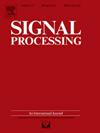Hurst exponent estimation using natural visibility graph embedding in Fisher–Shannon plane
IF 3.4
2区 工程技术
Q2 ENGINEERING, ELECTRICAL & ELECTRONIC
引用次数: 0
Abstract
In this article, two important stochastic processes, namely fractional Brownian motions (fBm) and fractional Gaussian noises (fGn) are analyzed, within a Fisher–Shannon framework. These processes are well suited for the realistic modeling of phenomena occurring across various domains in science and engineering. An unique feature that characterizes both fBm and fGn, is the Hurst parameter , that measures the long/short range dependence of such stochastic processes. In this paper, we show that these processes, from which we extract the degree distribution of the associated natural visibility graph (NVG), can be located in an informational plane, defined by normalized Shannon entropy and Fisher information measure , in order to estimate their Hurst exponents. The aim of this work is to map signals onto this informational plane, in which a reference backbone is built using generated fBm and fGn processes with known Hurst exponents. To show the effectiveness of the developed graphical estimator, some real-world data are analyzed, and it found that the estimated by our method are quite comparable to those obtained from four well-known estimators of the literature. Besides, estimation of parameter is very fast and requires a reduced number of samples of the input signal. Using the constructed reference backbone in the Fisher–Shannon plane, the associated exponent can be easily estimated by a simple orthogonal projection of the point extracted from the truncated degree distribution of the considered signal NVG representation.
求助全文
约1分钟内获得全文
求助全文
来源期刊

Signal Processing
工程技术-工程:电子与电气
CiteScore
9.20
自引率
9.10%
发文量
309
审稿时长
41 days
期刊介绍:
Signal Processing incorporates all aspects of the theory and practice of signal processing. It features original research work, tutorial and review articles, and accounts of practical developments. It is intended for a rapid dissemination of knowledge and experience to engineers and scientists working in the research, development or practical application of signal processing.
Subject areas covered by the journal include: Signal Theory; Stochastic Processes; Detection and Estimation; Spectral Analysis; Filtering; Signal Processing Systems; Software Developments; Image Processing; Pattern Recognition; Optical Signal Processing; Digital Signal Processing; Multi-dimensional Signal Processing; Communication Signal Processing; Biomedical Signal Processing; Geophysical and Astrophysical Signal Processing; Earth Resources Signal Processing; Acoustic and Vibration Signal Processing; Data Processing; Remote Sensing; Signal Processing Technology; Radar Signal Processing; Sonar Signal Processing; Industrial Applications; New Applications.
 求助内容:
求助内容: 应助结果提醒方式:
应助结果提醒方式:


